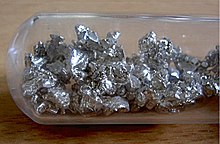 | ||||||||||||||||||||||||||||||||||||||||||||||||||||||||
| Calcium | ||||||||||||||||||||||||||||||||||||||||||||||||||||||||
|---|---|---|---|---|---|---|---|---|---|---|---|---|---|---|---|---|---|---|---|---|---|---|---|---|---|---|---|---|---|---|---|---|---|---|---|---|---|---|---|---|---|---|---|---|---|---|---|---|---|---|---|---|---|---|---|---|
| Appearance | dull gray, silver; with a pale yellow tint[1] | |||||||||||||||||||||||||||||||||||||||||||||||||||||||
| Standard atomic weight Ar°(Ca) | ||||||||||||||||||||||||||||||||||||||||||||||||||||||||
| Calcium in the periodic table | ||||||||||||||||||||||||||||||||||||||||||||||||||||||||
| ||||||||||||||||||||||||||||||||||||||||||||||||||||||||
| Atomic number (Z) | 20 | |||||||||||||||||||||||||||||||||||||||||||||||||||||||
| Group | group 2 (alkaline earth metals) | |||||||||||||||||||||||||||||||||||||||||||||||||||||||
| Period | period 4 | |||||||||||||||||||||||||||||||||||||||||||||||||||||||
| Block | s-block | |||||||||||||||||||||||||||||||||||||||||||||||||||||||
| Electron configuration | [Ar] 4s2 | |||||||||||||||||||||||||||||||||||||||||||||||||||||||
| Electrons per shell | 2, 8, 8, 2 | |||||||||||||||||||||||||||||||||||||||||||||||||||||||
| Physical properties | ||||||||||||||||||||||||||||||||||||||||||||||||||||||||
| Phase at STP | solid | |||||||||||||||||||||||||||||||||||||||||||||||||||||||
| Melting point | 1115 K (842 °C, 1548 °F) | |||||||||||||||||||||||||||||||||||||||||||||||||||||||
| Boiling point | 1757 K (1484 °C, 2703 °F) | |||||||||||||||||||||||||||||||||||||||||||||||||||||||
| Density (at 20° C) | 1.526 g/cm3 [4] | |||||||||||||||||||||||||||||||||||||||||||||||||||||||
| when liquid (at m.p.) | 1.378 g/cm3 | |||||||||||||||||||||||||||||||||||||||||||||||||||||||
| Heat of fusion | 8.54 kJ/mol | |||||||||||||||||||||||||||||||||||||||||||||||||||||||
| Heat of vaporisation | 154.7 kJ/mol | |||||||||||||||||||||||||||||||||||||||||||||||||||||||
| Molar heat capacity | 25.929 J/(mol·K) | |||||||||||||||||||||||||||||||||||||||||||||||||||||||
Vapour pressure
| ||||||||||||||||||||||||||||||||||||||||||||||||||||||||
| Atomic properties | ||||||||||||||||||||||||||||||||||||||||||||||||||||||||
| Oxidation states | common: +2 +1[5] | |||||||||||||||||||||||||||||||||||||||||||||||||||||||
| Electronegativity | Pauling scale: 1.00 | |||||||||||||||||||||||||||||||||||||||||||||||||||||||
| Ionisation energies |
| |||||||||||||||||||||||||||||||||||||||||||||||||||||||
| Atomic radius | empirical: 197 pm | |||||||||||||||||||||||||||||||||||||||||||||||||||||||
| Covalent radius | 176±10 pm | |||||||||||||||||||||||||||||||||||||||||||||||||||||||
| Van der Waals radius | 231 pm | |||||||||||||||||||||||||||||||||||||||||||||||||||||||
| Other properties | ||||||||||||||||||||||||||||||||||||||||||||||||||||||||
| Natural occurrence | primordial | |||||||||||||||||||||||||||||||||||||||||||||||||||||||
| Crystal structure | face-centred cubic (fcc) (cF4) | |||||||||||||||||||||||||||||||||||||||||||||||||||||||
| Lattice constant | a = 558.8 pm (at 20 °C)[4] | |||||||||||||||||||||||||||||||||||||||||||||||||||||||
| Thermal expansion | 22.27×10−6/K (at 20 °C)[4] | |||||||||||||||||||||||||||||||||||||||||||||||||||||||
| Thermal conductivity | 201 W/(m⋅K) | |||||||||||||||||||||||||||||||||||||||||||||||||||||||
| Electrical resistivity | 33.6 nΩ⋅m (at 20 °C) | |||||||||||||||||||||||||||||||||||||||||||||||||||||||
| Magnetic ordering | diamagnetic | |||||||||||||||||||||||||||||||||||||||||||||||||||||||
| Molar magnetic susceptibility | +40.0×10−6 cm3/mol[6] | |||||||||||||||||||||||||||||||||||||||||||||||||||||||
| Young's modulus | 20 GPa | |||||||||||||||||||||||||||||||||||||||||||||||||||||||
| Shear modulus | 7.4 GPa | |||||||||||||||||||||||||||||||||||||||||||||||||||||||
| Bulk modulus | 17 GPa | |||||||||||||||||||||||||||||||||||||||||||||||||||||||
| Speed of sound thin rod | 3810 m/s (at 20 °C) | |||||||||||||||||||||||||||||||||||||||||||||||||||||||
| Poisson ratio | 0.31 | |||||||||||||||||||||||||||||||||||||||||||||||||||||||
| Mohs hardness | 1.75 | |||||||||||||||||||||||||||||||||||||||||||||||||||||||
| Brinell hardness | 170–416 MPa | |||||||||||||||||||||||||||||||||||||||||||||||||||||||
| CAS Number | 7440-70-2 | |||||||||||||||||||||||||||||||||||||||||||||||||||||||
| History | ||||||||||||||||||||||||||||||||||||||||||||||||||||||||
| Discovery and first isolation | Humphry Davy (1808) | |||||||||||||||||||||||||||||||||||||||||||||||||||||||
| Isotopes of calcium | ||||||||||||||||||||||||||||||||||||||||||||||||||||||||
| ||||||||||||||||||||||||||||||||||||||||||||||||||||||||
Calcium is a chemical element; it has symbol Ca and atomic number 20. As an alkaline earth metal, calcium is a reactive metal that forms a dark oxide-nitride layer when exposed to air. Its physical and chemical properties are most similar to its heavier homologues strontium and barium. It is the fifth most abundant element in Earth's crust, and the third most abundant metal, after iron and aluminium. The most common calcium compound on Earth is calcium carbonate, found in limestone and the fossilised remnants of early sea life; gypsum, anhydrite, fluorite, and apatite are also sources of calcium. The name derives from Latin calx "lime", which was obtained from heating limestone.
Some calcium compounds were known to the ancients, though their chemistry was unknown until the seventeenth century. Pure calcium was isolated in 1808 via electrolysis of its oxide by Humphry Davy, who named the element. Calcium compounds are widely used in many industries: in foods and pharmaceuticals for calcium supplementation, in the paper industry as bleaches, as components in cement and electrical insulators, and in the manufacture of soaps. On the other hand, the metal in pure form has few applications due to its high reactivity; still, in small quantities it is often used as an alloying component in steelmaking, and sometimes, as a calcium–lead alloy, in making automotive batteries.
Calcium is the most abundant metal and the fifth-most abundant element in the human body.[8] As electrolytes, calcium ions (Ca2+) play a vital role in the physiological and biochemical processes of organisms and cells: in signal transduction pathways where they act as a second messenger; in neurotransmitter release from neurons; in contraction of all muscle cell types; as cofactors in many enzymes; and in fertilization.[8] Calcium ions outside cells are important for maintaining the potential difference across excitable cell membranes, protein synthesis, and bone formation.[8][9]
- ^ Greenwood, Norman N.; Earnshaw, Alan (1997). Chemistry of the Elements (2nd ed.). Butterworth-Heinemann. p. 112. ISBN 978-0-08-037941-8.
- ^ "Standard Atomic Weights: Calcium". CIAAW. 1983.
- ^ Prohaska, Thomas; Irrgeher, Johanna; Benefield, Jacqueline; Böhlke, John K.; Chesson, Lesley A.; Coplen, Tyler B.; Ding, Tiping; Dunn, Philip J. H.; Gröning, Manfred; Holden, Norman E.; Meijer, Harro A. J. (2022-05-04). "Standard atomic weights of the elements 2021 (IUPAC Technical Report)". Pure and Applied Chemistry. doi:10.1515/pac-2019-0603. ISSN 1365-3075.
- ^ a b c Arblaster, John W. (2018). Selected Values of the Crystallographic Properties of Elements. Materials Park, Ohio: ASM International. ISBN 978-1-62708-155-9.
- ^ Krieck, Sven; Görls, Helmar; Westerhausen, Matthias (2010). "Mechanistic Elucidation of the Formation of the Inverse Ca(I) Sandwich Complex [(thf)3Ca(μ-C6H3-1,3,5-Ph3)Ca(thf)3] and Stability of Aryl-Substituted Phenylcalcium Complexes". Journal of the American Chemical Society. 132 (35): 12492–12501. doi:10.1021/ja105534w. PMID 20718434.
- ^ Weast, Robert (1984). CRC, Handbook of Chemistry and Physics. Boca Raton, Florida: Chemical Rubber Company Publishing. pp. E110. ISBN 0-8493-0464-4.
- ^ Kondev, F. G.; Wang, M.; Huang, W. J.; Naimi, S.; Audi, G. (2021). "The NUBASE2020 evaluation of nuclear properties" (PDF). Chinese Physics C. 45 (3): 030001. doi:10.1088/1674-1137/abddae.
- ^ a b c "Calcium". Linus Pauling Institute, Oregon State University, Corvallis, Oregon. 1 September 2017. Retrieved 31 August 2019.
- ^ "Calcium: Fact Sheet for Health Professionals". Office of Dietary Supplements, US National Institutes of Health. 9 July 2019. Retrieved 31 August 2019.

